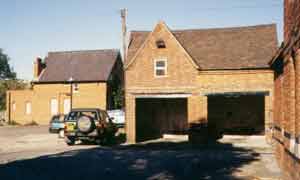![]()
The contents on this page remain on our website for informational purposes only.
Content on this page will not be reviewed or updated.
 |
 |
 At the rear of the station the original stables are to be found, slightly altered in appearance with some new brickwork where the small door to the former hay loft has been replaced with a window. The building has been slightly adjusted to house two motor vehicles, instead of the horse and chaise which was the means of conveyance for the Inspector to check his 'troops'. At the rear of the station the original stables are to be found, slightly altered in appearance with some new brickwork where the small door to the former hay loft has been replaced with a window. The building has been slightly adjusted to house two motor vehicles, instead of the horse and chaise which was the means of conveyance for the Inspector to check his 'troops'. |
|
| Further to the rear is a building for the Inspector, which replaced his dwelling when the main building was transfered to its present format as a police station. This building was demolished early part of 2002, due to it's dangerous condition. | |
| One of the four cells was allocated to the women prisoners. During the Second World War this was used to store the town's ration books. The end cell was used by the Home Guard to store their weaponry and ammunition. Originally each cell had an iron-grilled door. During recent times, a metal sheet was affixed, thereby cutting out some of the draught. | |
|
Reliable information given by the son of a former Inspector who lived on the premises was to the effect that hammocks were installed prior to the wooden benches. Similarly there is evidence with stubs of ironwork that a slop pail was located in the corner behind the door. When piped water replaced the hand pump originally located near the rear entrance, a toilet system was introduced at the end of the cell corridor. |
|
|
Much of this problem arose at the amalgamation of the five Forces which now represent the Thames Valley Police, namely the Bucks Constabulary, the Berkshire Constabulary, Oxford City Police, the Oxfordshire Constabulary and the Reading Borough Police. No doubt a number of documents were salvaged by individuals for personal souvenirs, rescued from the rubbish tip, before the understandable clamour arose to retain items of interest for future generations to examine. |
|
|
An interesting book is available in the museum: the Cell Book, which shows details of prisoners charged with various offences. A large number of entries cover the period of the First World War, listing names, regiments and where based, of absentees and deserters and how dealt with. The book is a record of the social history of the town, showing individuals tearing up their clothing in the hope they would receive a new outfit at the workhouse, and getting a taste of Hard Labour for their pains. |
|
|
ach station had to send a member to the Divisional station at Aylesbury, in order to up-date the orders. These were hand written in very neat script and show all movements, including joining, transfers, required to resign, and anything relevant to the working of the Force. We are fortunate that some of these records are available for perusal, some at the Newport Pagnell police museum, and some at The Thames Valley Police museum at Sulhampstead. Many unfortunately have been lost in the passage of time. Certain relevant documents are held in the Bucks County Museum at Aylesbury. |